Lilacs, found in moderate climates around the world, are known for their heady fragrance and variety of colors from deepest purple to palest pink, yellow, and white. But lilac blooms are not just ornamental, they are flavorful, too, and may be used to make a delicious and unusual extract for flavoring foods.
An extract is the concentrated essence of an ingredient; lemon, vanilla and almond extracts are common in most food markets. Extracts made from flowers are fun to make yourself, and spring is the perfect time to forage for lovely and edible blossoms that are at their peak for harvesting.
Making your own extract is a labor of love but well worth the effort. The unique concentrated flavor of a homemade extract will turn something ordinary into something extraordinary!
Blooms found on lilac shrubs or trees are perfect for making into extract that can be used to flavor baked goods like cakes, cookies and pies. It can be an amazing addition to a pastry cream for a special occasion and would certainly elevate a frosting or glaze.
The first extract I ever made was when I lived in Arizona. The fragrant blooms of an orange tree would fill our home with their rich and sweet fragrance. I just knew I had to learn how to make my own orange flower extract.
Now that I live on the east coast, spring brings lilacs, not orange blossoms. Lilacs are very temperature sensitive, so I was thrilled when the blossoms on my lilac bushes survived the late snows and frosts of this year’s harsh winter.
The process of making lilac extract will take about a week and once you begin, keep a close watch on the distillation process and the blooms on the bush. Homemade extract will keep for years, so make enough to last until your lilac blooms again.
The best time to harvest lilac blooms is either early in the morning or late in the day. If I am going to display the blooms in a vase, I like to cut the stems longer than I think I need and trim them to fit.
If you are foraging lilacs from your garden to make extract, you may want to enlist friends and family to help with the tedious job of removing the blooms from the stems. Put on some music and spend the time catching up on news while you carefully pluck the blooms.
You will need enough lilac blossoms for the two phases of the distillation process. Harvest enough blooms to complete both phases, and store the blooms for the second phase wrapped in wet paper towels in the refrigerator. This way, the blooms are ready for each phase of the distillation process and you avoid the risk of rain or wind damaging the flowers before they are harvested.
Homemade Lilac Extract
130 grams (4.5 ounces) lilac blooms, including small stems, will yield about 50 grams (1 ½ ounces) of plucked blooms, enough for both phases of the distillation process.
Ingredients:
25 grams (¾ ounce) pesticide-free lilac blossoms for each phase of the distillation process
237 ml (8-ounce) glass canning jar with a lid
Vodka to cover blossoms, about 237 ml (1 cup)
Sugar to taste (optional)
Preparation:
1 . Place the lilac blossoms, still attached to small stems, in a colander. Place the colander in the sink and gently wash the blooms.
2. Pluck or cut the blooms from each cluster, being careful to leave the green bit at the end which can cause the extract to taste bitter.
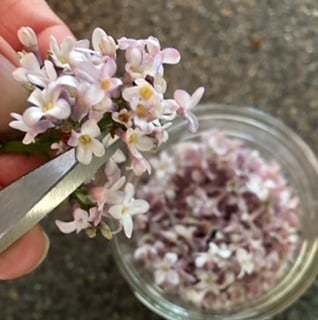
3. Fill an 237 ml (8-ounce) glass canning jar with the blooms to the fill line (or .6 cm/¼ inch from the top) as shown in the photograph. Carefully tap the jar on a surface to gently compact the blooms.
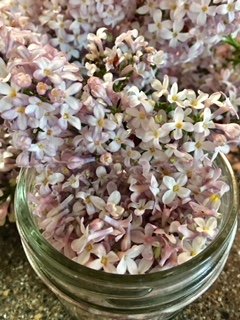
4. Pour vodka over the blooms to cover them completely, place the lid on the jar and turn to seal closed.
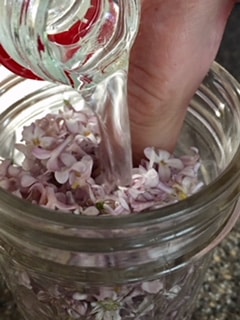
5. Place the jar in a dark place and allow the blooms to steep in the vodka until the blooms turn pale and nearly translucent. (This should take 2 days.) This is the first distillation phase.
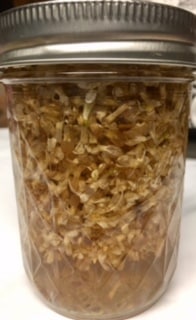
6. Drain the vodka and blooms through a fine mesh strainer set over a 473 ml (2-cup) spouted measuring cup and press firmly on the blooms to remove as much liquid as possible. Reserve the vodka infusion, which should now have a slightly floral scent but discard the lilacs.
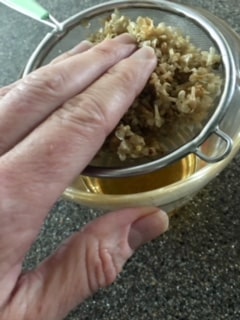
7. Fill the jar with fresh lilac blooms as before. This time, pour the reserved infused vodka over the top. Replace the lid and once again store the jar in a dark place until the petals become nearly translucent.
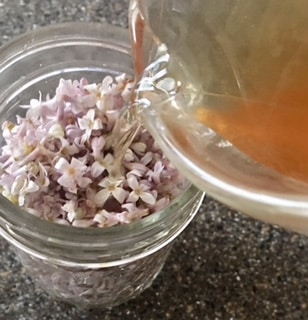
8. Repeat this process of straining and replacing until the vodka smells like lilacs, probably 4 times total.
9. When the infusion is strained for the final time, press out as much liquid as possible and discard the blooms as before. This time, strain the last infusion of liquid through a paper towel-lined fine mesh strainer into a clean 473 ml (2-cup) spouted measuring cup and taste the extract. If a pinch of sugar is needed to balance flavors, make that adjustment.
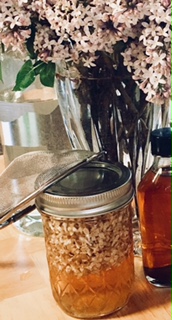
10. Pour the lilac extract into a glass bottle of choice, label, and store. Use whenever a recipe calls for extract. ![]()
